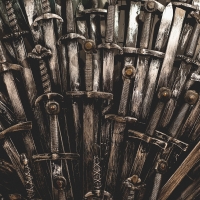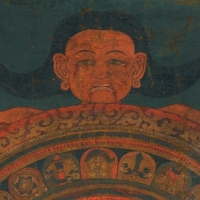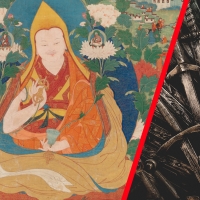
White Walkers, the last battle of Shambhala, and other stories of apocalypse
This post is part of a series exploring the connections between Game of Thrones and the dynamics of power in the world of Tibetan Buddhism. Warning: spoilers from seasons one through seven lie ahead.
What will it be like when the world ends? Apocalyptic and post-apocalyptic settings abound in today’s popular fiction, like the Game of Thrones series, which is based on George R. R. Martin’s A Song of Ice and Fire novels. The story foreshadows a final battle between darkness and light, anticipated to play out in the eighth and final season of the show. We frequently speculate on the end of the real world too. Almost every major world religion believes our world is destined to end, bringing about a spiritual renewal. The Himalayan religions of Buddhism and Hinduism contend that a period of decay and destruction is part of a cycle, followed by a new Golden Age and the triumph of the dharma. Such apocalyptic ideas have inspired art, some examples of which are in the Rubin Museum’s exhibition Faith and Empire: Art and Politics in Tibetan Buddhism.
He Brings the Storm
In Game of Thrones, the Children of the Forest, the original inhabitants of Westeros, originally created the White Walkers to fight off an invasion by humans. The White Walkers escaped the control of their creators and threatened all life on earth with their powers to bring darkness and winter and create armies of the dead. Eventually a prince, named Azor Ahai in the books, conquered them, wielding the magical sword Lightbringer and saving humanity from the original Long Night.
As season eight begins, an apocalyptic battle looms between the icy zombie army known as the White Walkers and humanity. The Night King has rebuilt his Army of the Dead, brought another fierce winter and Long Night, and is preparing to march south on Westeros. Although humanity may meet its doom, there is also a possibility of renewal.
Prophecies foretell a hero, a reincarnation of Azor Ahai or the Prince That Was Promised, will defeat the White Walkers, save the living, and usher in a new era. Some speculate that Danaerys is this prince, or rather princess, and she certainly asserts herself as a renewing force. She promises to “break the wheel” of feudal oppression once and for all.
Shambhala and the Last Battle
Western religions believe that God created the world and will end and renew it in a last battle of good and evil, known in Christianity as Armageddon. Himalayan religions have a more cyclical cosmology but also predict a future apocalypse. Each world cycle begins with a Perfect Age (Krita Yuga), followed by two ages of decline, before our present Age of Strife, the Kali Yuga. The Kali Yuga will deteriorate further, but after the destruction of the world, a new Perfect Age will begin and the dharma will triumph again. In Hinduism, Shiva is the god who continually destroys and recreates the cosmos.

Buddhism teaches that the Buddha’s dharma has a limited lifespan on earth and will necessarily decay. It is already more difficult to practice Buddhism than in the Buddha’s day, and eventually there will be no more practice or knowledge of Buddhism. Maitreya, the bodhisattva crown prince, will then return as the next buddha. He will usher in a new Golden Age of Buddhism, teach the dharma, and lead beings to awakening. Mongols after the seventeenth century were particularly devoted to Maitreya, believing he would restore the Mongol Empire to glory. A sculpture of Maitreya from this era, on loan from Harvard Art Museums/Arthur M. Sackler Museum, is on view in Faith and Empire.

The Kalachakra tradition similarly prophesizes a future war between the kingdom of Shambhala, which will preserve the dharma in dark ages, and the barbarian mlecchas, whose defeat will usher in a new Golden Age. Buddhist societies across ages have recast the story to address the threats they faced. A nineteenth-century Mongolian painting in Faith and Empire depicts the forces of Shambhala in Mongolian garb defeating the barbarian hordes. It was painted at a time when nineteenth-century Christian and Muslim rebellions threatened the Qing Empire. Although the world of Mongolian Buddhists was crumbling, the painting expressed a hope that out of the ashes a new era of the dharma would begin.
Doom or Hope?
The world as we know it will not last forever. Will this doom us or empower us? Doomsday scenarios—global warming, nuclear war, scientific experiments gone awry—express modern anxieties, such as our ability to control technology. Works of fiction like Game of Thrones also express these anxieties, imagining a world that may end in doom, but possibly with a better world rising from the ashes.
Himalayan religions likewise emphasize the impermanence of the world, but this does not mean doom. According to Tibetan Buddhism, the end of our world will usher in a new era in which everyone can practice the dharma, achieve awakening, and escape the wheel of suffering. Many artworks at the Rubin and in Faith and Empire express this hope.
Take a special Game of Thrones tour of the Rubin Museum and learn more in the exhibition Faith and Empire: Art and Politics in Tibetan Buddhism, on view February 1–July 15, 2019.
About the Contributor
William Dewey is a curatorial fellow at the Rubin Museum. He recently completed a PhD in Tibetan Buddhism from the University of California, Santa Barbara, and spent a year teaching at the Rangjung Yeshe Institute in Kathmandu.






